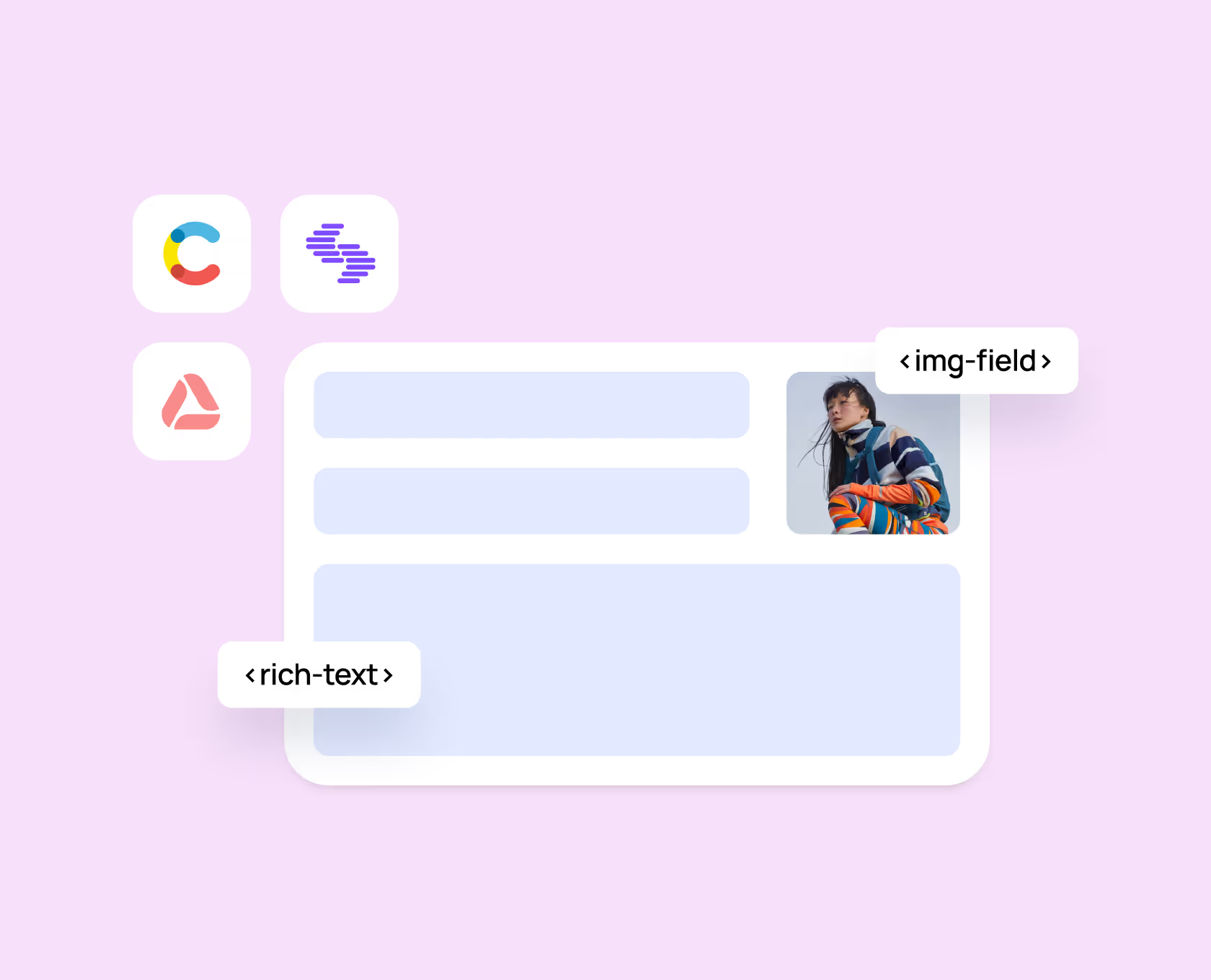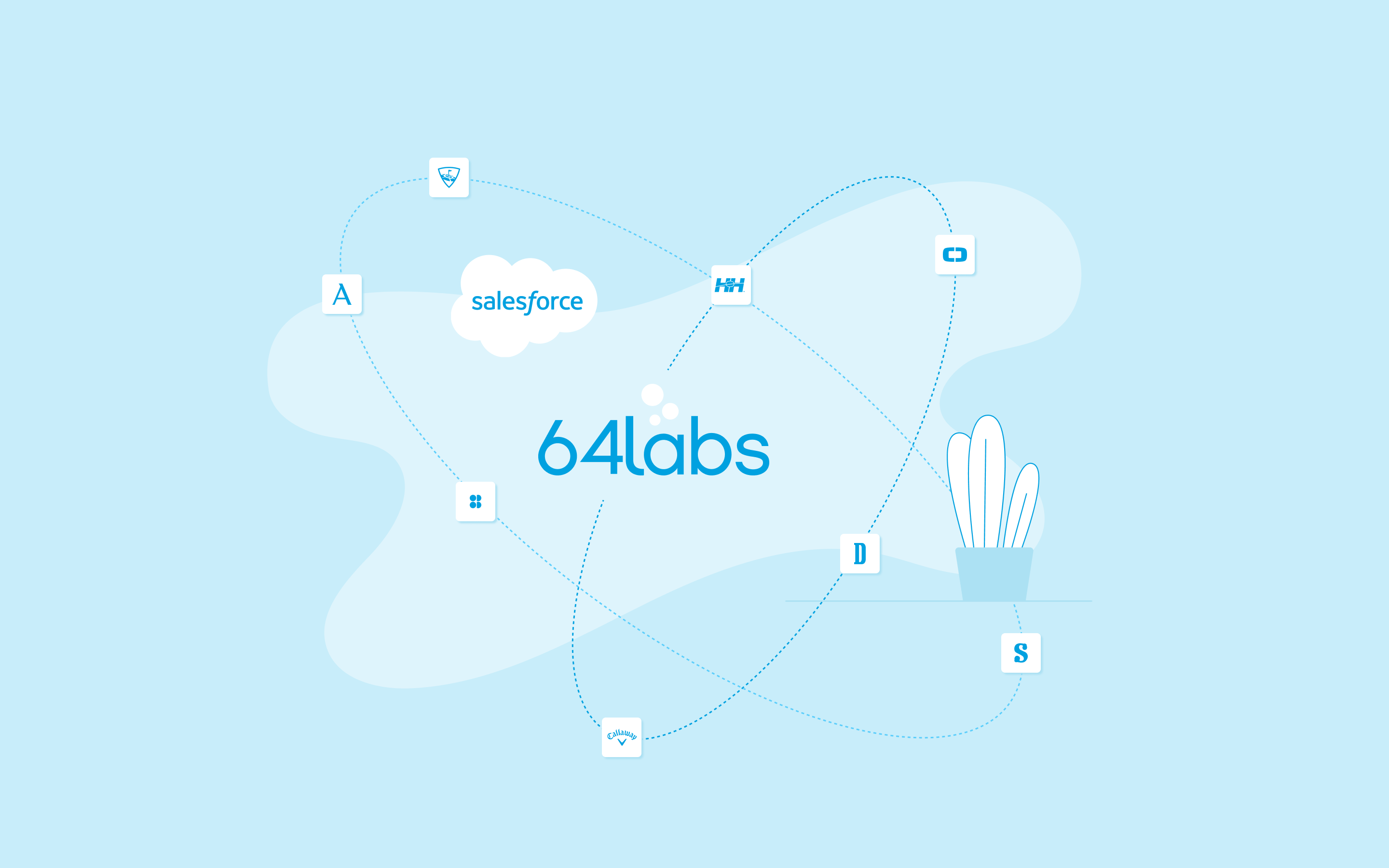
Partners with Contentstack, Amplience and Contentful
Headless CMS Implementation
We help brands implement leading platforms like Contentstack, Amplience, and Contentful to accelerate content velocity, streamline workflows, and enable omnichannel publishing. From modeling to migration, our approach ensures seamless integration with your composable stack and long-term scalability.
Proven Expertise
We have a track record of 10+ Headless CMS migrations and launches for brands with vast content and various complexity: multi-brand, multi-site, multi-locale
Accelerated Delivery
Our AI-powered tools and repeatable frameworks reduce complexity and speed up CMS adoption—so you see value in weeks, not months.
Seamless integration
We connect CMS platforms directly into your commerce stack, ensuring content, product data, and personalization tools work together from day one.
Scalable Workflows
From modeling to migration, we design workflows that grow with your team — enabling faster content velocity and omnichannel delivery.
What is included in Headless CMS Implementation?

Content Discovery
We start by mapping your existing pages and content into a reusable component architecture. This will include content from existing CMS, HTML content assets and custom html. We want to unify all content into one easy to manage system.

Content Architecture
We define scalable content models tailored to your business, enabling reusable components, localization, and omnichannel delivery, and map the models to components on Front-End. into a concise and versatile system.

Content Migration
We migrate your content with minimal disruption, ensuring data quality, consistency, and alignment with the new CMS architecture. We normalize the content components eliminating hundreds of "one-off" cases.

Documentation
We create clear, detailed documentation for your CMS architecture, components, and workflows—so your team has full ownership and confidence moving forward.

Empowering the Internal Team
We equip your teams with the skills to succeed—covering authoring, workflows, governance, and best practices for headless publishing. Not only by providing training, but also engaging internal stakeholders to practical content creation in preparation for the Launch.

Launching the New CMS
We don’t just configure—we launch. Our team manages cutover with proven practices, whether phased rollout or big bang, ensuring zero downtime. Post launch, we provide hands-on support to stabilize operations, optimize workflows, and fine-tune integrations for long-term success.
Platforms Integrations
We work with leading headless CMS vendors to deliver reliable, enterprise-grade composable solutions.

We integrate Amplience when brands need to manage and deliver rich, dynamic content at scale. Its strengths in digital asset management, video, and image optimization make it ideal for ecommerce experiences where performance and high-quality media go hand in hand.

We recommend Contentstack for enterprise teams that need flexibility, governance, and localization. Its API-first architecture and enterprise-grade workflows make it a strong fit for global commerce businesses looking to accelerate publishing while keeping control.

We bring in Contentful for brands that value developer agility and omnichannel delivery. With a robust API ecosystem and extensible content model, it supports rapid iteration and multi-channel content experiences, making it a popular choice for fast-moving ecommerce teams.
Not Sure Where to Start?
Find Out If You’re Ready for Composable
Before investing in Composable Replatforming, it’s crucial to understand how your tech stack, workflows, and team will adapt. Our free Composable Readiness Assessment gives you a clear roadmap — minimizing risk and accelerating delivery.
FAQ
Headless CMS Implementation FAQs: Everything You Need to Know
A headless CMS frees content from the constraints of legacy, page-based tools. Instead of being locked to one storefront or channel, your team can create content once and deliver it everywhere - web, mobile, apps, in-store displays, and beyond. It also empowers marketers to publish faster, experiment more, and respond to market shifts without depending on developers for every update. For enterprises running on platforms like SFCC, a headless CMS is often the missing piece that turns commerce into a truly composable, flexible, future-proof ecosystem.
Migration isn’t just copy-paste—it requires careful planning. We start with a full content audit, mapping what exists today and what should be restructured for tomorrow. Then we design transformation rules, automate as much of the migration as possible, and validate results in a staging environment. Along the way, we fix legacy issues like inconsistent tagging, broken links, or outdated assets. Finally, we perform parallel runs and cutover in a way that minimizes downtime and preserves SEO equity.
Yes. We believe adoption is just as important as implementation. Our training is role-based - editors learn how to author and manage content, marketers focus on workflows and governance, and developers get guidance on components, APIs, and extensions. We also leave behind comprehensive documentation for your content models, components, and integrations, so your team can operate independently. Many clients tell us this training is what helps them achieve value immediately after launch.
We build SEO protection into the migration plan. That includes preserving URL structures wherever possible, implementing 301 redirects for changed paths, carrying over metadata and structured data, and validating performance post-launch. We also run crawls before and after cutover to catch broken links or missing tags early. Combined with phased rollout options, this approach ensures your organic visibility isn’t just maintained - it often improves with faster page performance.
Timelines depend on content volume, integrations, and complexity of workflows. Most enterprise implementations take 12–20 weeks, including modeling, integration, and migration. We accelerate delivery with pre-engineered tools, automation for migration tasks, and repeatable frameworks. The goal isn’t just speed, but ensuring the CMS is production-ready, your team is trained, and your workflows scale smoothly from day one.
We approach launch as a managed process, not a hand-off. All our approaches are backed by automated tests, monitoring dashboards, and rollback strategies. Post-launch, we run a “hyper-care” period to stabilize CMS operations, fine-tune integrations, and coach your team through real-world publishing scenarios. Our goal isn’t just to go live—it’s to make sure your CMS is delivering value from day one.
Perspectives worth sharing

5 min read
•
November 6, 2025
What Happened to the MACH Alliance? Why Composable Commerce Moved On in 2025
The MACH Alliance had the acronym, the swagger, and a damn good mission. It stood for Microservices, API-first, Cloud-native, and Headless. The idea was to push the e-commerce world away from monoliths and toward a modular, best-of-breed stack. For a while, it looked like it was going to work.. Vendors joined. Events got crowded. Whitepapers landed in inboxes like fragrant rose petals. It felt like a movement.
But here in 2025, the shine has dulled. MACH Alliance mentions have slowed to a trickle. Retailers aren’t opening RFPs with the acronym circled in red ink. The website still exists, but you’d be forgiven for wondering whether MACH is a revolution that quietly stopped revolving.
So What Happened?
Let’s start with the truth that no one at MACH wants to admit: most retailers don’t have a MACH problem. They have an ROI problem, a velocity problem, and a bandwidth problem. They need to move faster, convert more customers, and do it without tripling their headcount or budget. MACH promised architectural freedom. Retailers needed business agility.
Composable Is Still Thriving
Composable commerce is still very much alive. In fact, it’s thriving. At 64labs, we’ve implemented ten full composable storefronts for brands on Salesforce Commerce Cloud alone. But what wins in the market today isn’t dogmatic adherence to MACH principles. It's a practical, performance-driven composable strategy. That doesn’t always line up with the idealism MACH was selling.
Take microservices. Sounds great in theory. Break everything into modular pieces that can be swapped and optimized. But in practice, who’s got the team to manage dozens of services, each with its own SLA and quirks? Most ecommerce teams need fewer moving parts, not more. Smart composable builds cluster services logically. They minimize overhead while unlocking flexibility where it matters.
Headless? We’re all in. But headless for the sake of headless is a mistake. You need a head that performs, that loads in milliseconds, and that your marketing team can actually use without begging IT. That’s why we partner with tools like Amplience, Contentstack, Dynamic Yield, and Algolia. Not because they’re MACH-certified, but because they make our clients’ lives easier and deliver results.
Cloud-native? Sure. But let’s not pretend this is some radical stance in 2025. Everyone is cloud-native now. If you’re not, you’re either Oracle or a hobbyist.
API-first? Of course. But Salesforce’s OCAPI has been around longer than MACH itself. These aren’t differentiators anymore. They’re table stakes.
What Retailers Actually Need
What retailers really need is a partner who understands how to make composable commerce deliver ROI fast. They want bounce rates down and conversion rates up. They want to launch campaigns in days, not weeks. They want to test personalization and AI features without rewriting the whole front end. MACH never showed them how to get there. It just handed them a really cool toolbox with a bunch of very expensive tools.
The CEO of ecommerce platform Vtex Mariano Gomide de Faria, who suspended their membership of MACH Alliance this year, summed up some of the reasons they made the switch.
- Integration Complexity: Organizations face overwhelming challenges trying to connect a myriad of APIs and vendor solutions, leading to fragile systems where small changes can cause widespread failures.
- Surging Costs: The cost of integrating, licensing, and maintaining multiple systems often far exceeds expectations. Businesses find themselves distracted from their core mission and end up spending heavily on ongoing operations and vendor management.
- Operational Burden: The fragmented nature of best-of-breed solutions results in disconnected workflows, forcing business users to juggle multiple interfaces. This slows productivity, increases training costs, and damages business agility.
- Security and Privacy Weaknesses: Data is often unnecessarily duplicated across platforms, exposing organizations to compliance and privacy risks. Managing security across many vendors is extremely difficult and can result in regulatory gaps.
- Dogmatic Ideals vs. Business Value: MACH principles, while now common in web app development, are criticized as having become dogmatic, focusing more on technical ideals than on delivering real business outcomes.
Why Salesforce Quietly Pulled Ahead
This is where Salesforce Commerce Cloud has quietly pulled ahead. It didn’t join the MACH Alliance. It didn’t need to. It just evolved. It became de-composable which actually fits better with how customers actually approach a composable journey. Today, SFCC supports headless builds, open integration, and structured APIs. And it’s got a composable storefront accelerator that lets brands move quickly without sacrificing scale. That’s why we’ve seen brands like Moncler, Sweaty Betty, and Iceland go composable with Salesforce and win.
The Legacy of MACH
MACH’s real legacy might be that it created the space for composable to become mainstream. It shifted the conversation. It made monoliths feel like legacy tech. But the Alliance lost momentum because it clung too tightly to its acronym. The future of commerce isn’t about boxes checked on a technical spec sheet. It’s about what actually works.
So if you’re a retailer wondering what happened to the MACH Alliance, here’s your answer: it served its purpose. But the future belongs to brands and partners who can execute. Not just theorize. Not just rebrand old tech with a shiny acronym. The winners are the ones who get composable done fast, clean, and in a way that puts marketers back in control of their digital experience.

5 min read
•
November 7, 2025
Scroll Anxiety: The Hidden UX Problem Killing Ecommerce Conversions
Let’s get this out of the way first: yes, users scroll. No, the fold is not sacred anymore. But if you think that means design hierarchy doesn’t matter, you’ve missed the real issue.
The problem is scroll anxiety.
Scroll anxiety is what happens when a customer lands on your page and their eyes don't know where to go. The layout looks busy. The content feels disorganized. The first scroll happens out of confusion, not intent. And then they leave.
It’s not a fear of scrolling. It's a fear of wasting time.
How to recognize scroll anxiety in your ecommerce experience
You’ve probably seen it and called it something else. Low scroll depth. High bounce. Weak engagement on key pages that look “beautiful” in Figma but confuse real customers.
Scroll anxiety shows up in the moments where everything is technically working, but the site feels like it’s trying too hard. You’ve got motion, video, product carousels, loyalty promos, and AI recommendations all competing for attention. But nothing is clear.
Customers scroll. They just stop caring by the second screen.
Scroll depth doesn't mean engagement
We’ve seen brands celebrate deep scroll data and still wonder why conversion is flat. One scroll doesn’t equal one step closer to purchase. In most cases, it’s the opposite.
When the layout sends mixed signals, your customer scrolls because they don’t know what else to do. They aren’t convinced. They’re scanning for clarity.
And if they don’t find it quickly, they leave.
What to do instead
This isn’t about flattening your design or avoiding features. It’s about sequencing and clarity. Every page on your site needs to solve a real problem for the customer, do what they want it to do, or earn the next scroll.
Here’s what that looks like:
- One core message per screen: Prioritize clarity over cleverness.
- Consistent content hierarchy: Important things should look important.
- Performance-driven frontends: A composable frontend should feel faster and cleaner, not heavier. Structure above and below-the-fold calls accordingly.
- Test real behavior: Not just scroll depth, but where people stop reading and why.
Clean beats clever. Simple wins
When we rebuild ecommerce frontends for brands like e.l.f. and Duluth Trading, we see bounce rates drop 20 to 40 percent. Some of this is just pure performance improvement. The customer doesn’t have a delay that gives them a reason to stop. Some is because we look to reduce the noise, cut the number of elements.
We try to make every screen sized section a user can scroll to do one job. We stop assuming attention and try to understand what users are likely to do next. And we made sure each scroll is earned - through empathy rather than confusion.
Scroll anxiety creeps in when the design gets clever and forgets to be clear.
Don’t let your new stack become your next problem
You didn’t go composable just to confuse users faster. You made the move so teams could ship faster, test smarter, and create experiences that convert. Design is part of the composable journey. We normally change as little as we can for the first iteration of composable frontends for clients. But we follow with a momentum phase focused on tightening the experience, improving performance where it matters and understanding how real users behave.
If the customer is scrolling without understanding, the stack isn’t doing its job.
If your scroll data looks good but revenue isn’t moving, there’s a gap between what your site is trying to say about your brand and what users are hearing.
Scroll anxiety is an attempt to tell you this. You have to know how to listen.

5 min read
•
October 30, 2025
Why 64labs leads the pack in enterprise composable builds on Salesforce Commerce Cloud
Building Composable Storefronts for Global Brands: The 64labs Perspective
Implementing the Salesforce Commerce Cloud PWA Kit Composable Storefront for major multi-region retailers - such as Horizon Hobby (US, UK, Europe), Aritzia (US, Canada), e.l.f. Beauty (global), Callaway Golf (US, UK, EU), Sweaty Betty (US, UK), and Moncler (US, Europe) - has provided 64labs with deep insight into the real-world complexities and rewards of composable commerce.
Here are our experiences tackling challenges that you may think are the domain of the bigger consultants in the space.
Global Complexity and Localization
Multi-region launches are significantly more complex than single locale rollouts. Each market brings its own requirements around currency, taxes, languages, product catalogs, and fulfillment workflows. For example, supporting Horizon Hobby’s diverse multi-brand US, UK, and EU customers meant building storefronts with tailored content, payment options, and regional logistics, managed by a high-performance frontend able to localize rapidly and stay performant across geographies.
The Challenge of Seamless Headless Integration
PWA Kit enables a fast, responsive headless experience, but decoupling the frontend from legacy Salesforce templates like SiteGenesis and SFRA means e-commerce teams must re-engineer core workflows (content orchestration, promotions, and personalization) using modern APIs. Our Accelerator helps bridge this gap, but the learning curve for retailer tech teams is steep: optimizing data sync, managing distributed caches, and ensuring business users retain control over digital merchandising are ongoing challenges, especially when transitioning multiple legacy systems into a single composable experience.
Performance, Scalability, and Reliability
Operating sites across continents means performance optimizations are mandatory. Deploying the PWA frontend near Salesforce’s data centers for each region keeps sites fast and reliable, minimizing latency for users in North America, Europe, and beyond. Callaway Golf (which was a Vercel-NextJS build) and Sweaty Betty relied on 64labs to monitor, tune, and upgrade their storefronts to maximize speed, stability, and conversion rates at launches during peak shopping periods, supported by dynamic scaling in Salesforce’s managed runtime or Vercel’s infrastructure. There’s a lot to understand.
Governance and Collaboration
A multi-brand or multi-country rollout involves complex stakeholder dynamics. Each retailer division or geo needs some autonomy while benefiting from shared components and architecture for long-term maintainability. For Moncler, empowering distributed merchandising and content teams to personalize each market’s storefront, without sacrificing technical standards or conversion best practices, has been key to driving global e-commerce growth.
Learning Curve: Enabling Teams for Success
Transitioning from legacy templates to PWA Kit requires upskilling: dev teams must pivot from monolithic approaches to API-first thinking, while marketers need new tools for content orchestration outside Business Manager’s clunky but familiar interface. Our Accelerator was built to flatten this curve, providing high-quality scaffolding, reusable modules, and training, so merchants and marketers can drive timely changes without relying exclusively on technical resources. To deliver enterprise-wide benefits there has to be change and learning across the enterprise to understand and exploit the opportunities of the new stack effectively.
Real-World Takeaways
Implementing PWA Kit for global retailers has been a test-and-learn journey. Early rollouts like Sweaty Betty’s US storefront proved that composable approaches deliver measurable performance and conversion gains when agile teams, best-practice frameworks, and iterative deployment are combined. Brands like e.l.f. Beauty and Callaway Golf continue to refine and expand their composable strategy, integrating loyalty, content, and search for ever-more personalized customer journeys.
The challenges of scaling PWA Kit for global retailers are significant - from technical integration and localization to stakeholder governance and organizational learning. But with the right approach, composable commerce is not just a technology shift - it’s an opportunity for brands to deliver world-class, market-tailored digital experiences at speed and scale.
For 64labs, every launch brings new lessons, and each success reaffirms the value of deep technical expertise, collaborative partnership, and relentless focus on merchant empowerment. For enterprise scale composable storefront launches on Salesforce, 64labs is probably the most experienced implementer in the world.


